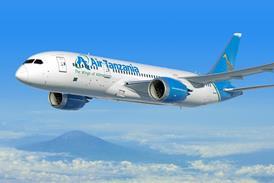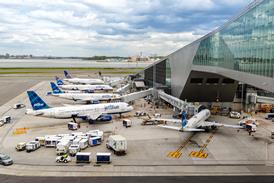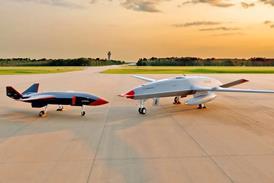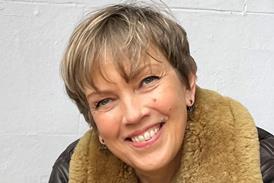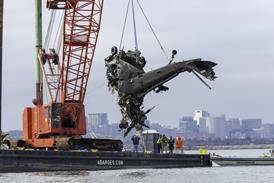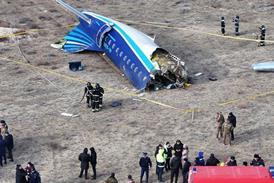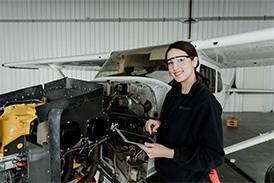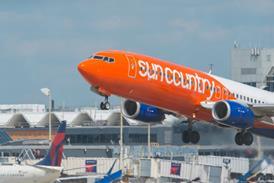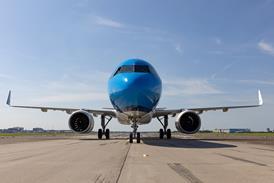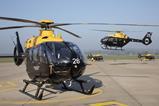Aeralis stands ready to drive forward with its groundbreaking modular aircraft programme, with the UK start-up saying that securing a first customer commitment in the coming months will enable it to deliver an operational advanced jet trainer (AJT) early next decade.
Showcasing its progress during an industry event at proposed industrial partner StandardAero’s Gosport site in Hampshire from 29 April to 1 May, Aeralis pledged to achieve first flight within 42 months of receiving backing from a launch customer.
The company’s market studies indicate that its aircraft family should be able to attract orders for around 500 units, although chief operating officer Neil Barnett notes that this is a conservative figure. “The [BAE Systems] Hawk did 1,000, and we hope to beat that,” he says.

Heading its sales target list are the UK and France, which Aeralis believes will have requirements for a combined 100 aircraft. Each of the nations’ air forces will need to acquire around 15 jets to re-equip their aerobatic display teams, and potentially the same number for use in the ‘red air’, or aggressor support role.
Another 20 aircraft per customer would enable the UK to replace its current Hawk T2 trainers, and France to introduce new assets in an operational support role, it says.
“Based on a bilateral programme there could potentially be an equal workshare split,” Barnett says, with airframe and aircraft systems sourced from both countries.
FRANCO-BRITISH APPEAL
“In our opinion, there should be a joint Franco-British approach to this product,” Aeralis chief executive Tristan Crawford tells FlightGlobal in an exclusive interview. “Both nations’ needs and timings are very similar,” he notes, while suggesting: “both from a military and a political perspective this is a really good solution”.
“There has been a lot in the press about the remaining life of the [Royal Air Force’s] Red Arrows fleet,” Crawford notes, with the iconic team’s aged Hawk T1s expected to leave service around 2030.
“At the same time, we have got a government that is looking to invest in defence and the UK and promote sovereign control over its equipment.
“If you have got an institution like the Red Arrows, promoting the best of British aviation – not only our flying skills but also our equipment – then this is the time where one has to look at standing behind that,” he urges.
Noting that Aeralis proposes supplying its aircraft through an operating model via industry service providers, he says: “This is the moment. We have UK industry coming together proactively, to bring in private investment to deliver this capability in an innovative way which reduces cost significantly for the taxpayer.
“With this arrangement, we would propose that it’s never been more investable,” he claims. “This is something that industry can take the risk on.”
Aeralis’s solution will bring “jobs, inward investment and growth”, he says, with the company claiming the programme could support 6,000 highly-skilled posts.

Pointing to budgetary pressures in the UK as it advances its Strategic Defence Review (SDR), and moves on a path towards boosting defence expenditure first to 2.5% and then 3% of gross domestic product by the end of the decade, he notes: “Solutions which bring funding and capability that don’t require capex [capital expenditure] from the government must be of interest.”
LOW-RISK APPROACH
He describes a sought-after pledge “to use the aircraft once it’s available” as representing “low to zero risk” for a customer. “Not a penny of taxpayer money is spent before the aircraft flies,” he says.
Meanwhile, pointing to Doha’s state-owned sovereign wealth and military procurement body Barzan Holdings as being a long-term investor in Aeralis, Barnett says Qatar also has a potentially 20-aircraft need. That would cover 10 AJTs, plus display team assets.
While it hopes to launch activities on the receipt of commitments for around 120 jets, Barnett says the company “could make it work” with a smaller figure.
The innovative core common fuselage (CCF) for Aeralis-family aircraft will be manufactured, assembled by Hamble Aerostructures in Southampton, before being transported the short distance to StandardAero’s Gosport site for equipping with internal systems. Aernnova-owned Hamble – which was previously heavily involved in the Hawk and its Boeing T-45 Goshawk derivative programmes – will also be responsible for producing the aircraft’s canopy and windshield.

Aeralis expects the initial fabrication and assembly of the CCF using a traditional aluminium rib and stringer design to take 120 days, with the equipping process in Gosport to take a further 60 days. Final assembly would take a further 60 days, although the overall time would reduce as aircraft numbers increase.
The company, which is in the process of selecting a formal product name for its aircraft family, also continues to assess potential final assembly locations, with a survey of 67 sites in the UK having narrowed to five candidates.
It identifies one of these – at Prestwick airport in Glasgow, Scotland – as having recently grown in interest.
“You need an installed aerospace skills base around you,” says Crawford, who notes that the company has also considered factors such as requiring 24/7 access to a long runway. “And from a political perspective, we are supporting the [UK] government agenda to promote growth in the regions, as well as England,” he adds.
“We were really impressed with the combination of those factors that came together in Prestwick.”
However, the eventual location of the line – and likely also a maintenance, repair and overhaul hub at the same site – could be determined by which customer nation commits to the programme first.
Another possibility could be to establish a line at an existing industrial site in the south of France, Barnett suggests. However, he notes: “We could have multiple final assembly lines, but we have got to be careful with the economics. A line could be regional, and maybe not for an individual customer.”
Aeralis already has an office in France, which he says enables it to keep close to a prospective customer, but also will assist with a future certification activity, to be performed with the European Union Aviation Safety Agency.
THIN PRIME
Barnett describes the company’s planned operating model as that of a “thin prime”, with its product family to draw extensively on available technology from its ‘Aerteam’ partners and others. “We have selected equipment that exists and is in service today,” he says.
Examples include the F124 engine, environmental control system and auxiliary power unit from Honeywell, and a Heroux-Devtek-produced landing gear with minor modifications and improvements from that used on the Hawk.
The aircraft will be equipped with Martin-Baker ejection seats – either in the Mk18 or Mk16 models – able to accommodate students and instructors in JPATS cases 1 (lightest/shortest) to 7 (heaviest/tallest) categories.
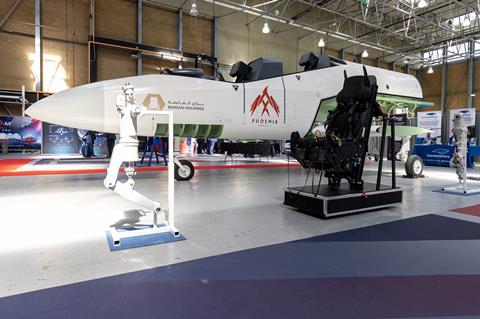
Aeralis also has had discussions with Leonardo around flight control system and cockpit display technology.
With a large amount of pre-launch work already completed, the developer would expect to conduct a preliminary design review activity in the second half of 2026 if a launch decision comes soon, followed by a critical design review in the first half of 2027.
Programme director Colin Thornton says the planned schedule would see the first flight of its lead of four ‘Phoenix’ flight test vehicles occur 42 months from the point at which one of its target customers commits to the programme. Type certification for the AJT model would follow approximately two years later.
“We have been working for the last three years to get where we are now, to mitigate the risks,” says Thornton. “We had a risk register of about 300 items and have worked to reduce those down to 178 at the moment – and those are at a lower level.”
Referring to a design change revealed in September 2023, which moved the wing from a mid-fuselage position, Thornton notes: “Going to a lower wing was a huge way of reducing risk, so we could use a landing gear that already exists.”

Aeralis had performed windtunnel tests with a scale model of its previous configuration, before potential future operators highlighted the need to further improve performance.
“Customers were telling us that we needed Mach 0.9 straight and level performance,” says chief engineer Tim Williams, who notes that the new design is capable of achieving M0.92, without the need for the customary dive of subsonic AJT platforms.
SWEET SPOT
“We have found the sweet spot,” he says, while adding: “the [operational] envelope may fit all of our customer requirements”.
“The AJT market has historically focused on very high-end performance, effectively emulating a combat aircraft and operating in areas of the envelope that are very demanding,” Crawford says. “We believe in taking an approach where we dial it down a notch – we keep the aircraft transonic and use smaller, more available and affordable turbofan engines,” he explains.
“The innovation and game changer is in making the airframe and the digital architecture as flexible as we possibly can. The rest of it is very straightforward, conventional aircraft design, production and support.”
Given the high level of commonality between the modular aircraft family – which is expected to be in the 60-80% range in terms of spares and equipment – Thornton says Aeralis expects to be able to deliver additional variants at intervals of two years each “at fractions of the typical cost”.
The company has detailed a range of potential versions, which would feature either a single- or twin-engined layout, including reheat options, or a different wing for advanced handling performance with an armed variant, or for extended endurance tasks. Changes could also require the addition of a fuselage-lengthening plug behind the CCF structure, or a different nose section to accommodate a radar.

Risk-reduction work has also included using the Aeralis Smart Integrated Digital Enterprise (AERSIDE), which capability director Anton Burford says integrates the programme from design and development through flight-test and operational service.
“We are taking time to make sure that the system is right,” he says. “The system architecture is being scaled for multiple companies as daily users, so we are ready.” Additionally, “As Aeralis uses AERSIDE as a single source of data truth, the digital data for the simulator is actually being generated as we develop the aircraft. We are already running software that will go into the aircraft, because it is the same,” he notes.
“Everything we are doing has a digital twin,” Burford says. “That helps for the life of the aircraft and to support digital certification evidence, which remains new. Bringing the regulators in with us on that journey helps the community to get ready.”
In October 2024, the company developed an electrical system test rig called Project Helix. This will support its system development work and “prove the concept through its end-to-end digital thread that integrates the certification output into the ways of working”, Burford says.
DIGITAL FIRST
By using such technology, the programme will be able to conduct a “digital first flight” one year before the actual lead aircraft takes to the air, he notes.
Extensive 3D digital modelling has enabled designers to fully consider factors such as display screen positioning and the location and accessibility of maintenance panels for line-replaceable units, for example. Working with Siemens, it can emulate the layout and efficiency of final assembly and MRO stations before even cutting metal on the aircraft, by drawing on the so-called ‘industrial metaverse’.
Once the aircraft is in use, Burford notes that safety and airworthiness data which would benefit all users will be split from operational data which individual nations might want to segregate.
The company aims for its digital cockpit to be capable of emulating the displays found in frontline fighters, such as the Rafale, Eurofighter Typhoon and Lockheed Martin F-35.
“Our goal is to save 50% in through-life costs,” says aircraft availability director Mark Williams. “We have got the advantage of modularity, and repurposing for multiple roles.” As an example, an operator could use a jet in a basic training or AJT role for several years and then have it modified for less demanding roles to extend the aircraft life.
“It’s a competitive advantage, for example if we are working with a third-party [training provider],” he notes.
Aeralis says it aims to deliver commercial-sector levels of aircraft availability – in the “high-90%” bracket, rather than the “40 to 50%” typically seen with some military models.
“Because we started early, this programme has had an unprecedented amount of attention on technology, and that will make it a success,” Barnett says. “Now we are able to talk to customers with a level of confidence.”
Crawford says the open-house event was “all about inviting those customers to come and see the ability of this consortium to do this”.

“What you see around you here today is a maturity that you would normally never get at this stage of a programme, in terms of industrial partnerships, before a programme has launched,” he says. “And there is nothing unusual in committing to a project that hasn’t yet got the product [flying],” he adds.
“The equipment is all there, the toolset to integrate it digitally is ready, and we’ve got the design. We’re waiting at the starting gate for someone to lift the door.”
Asked whether an established airframer could take on the project at this point, he counters: “We believe that to generate this kind of aircraft at a price point the market can afford, you need to take a smaller organisation approach, co-opting in all of the great skills, partnerships and capabilities that the UK already has.”
“With our investment partners and a customer commitment, we will have the ability to capitalise the programme through to first flight and certification.
“We are so lucky to have the investors that we have, who understand what this involves,” he says, referring to Barzan. “In terms of who picks us up first, they will support it. And if it’s not the UK, this will happen somewhere else.”
With London expected to publish its SDR by around July, he notes: “The [UK] customer is not yet clear, but there are customers not far from here who are becoming clear.
“Given the once in a generation opportunity for the UK to ensure there is a British-designed and -built aircraft to equip the future Red Arrows at no upfront cost to the UK taxpayer, we sincerely hope that the UK will take advantage of what’s now on the table.”
Aeralis executives will be busy at the Royal International Air Tattoo at RAF Fairford in Gloucestershire from 18-20 July, with the company having increased the size of its hospitality chalet.
“We anticipate that this is kind of the year,” Crawford says.


